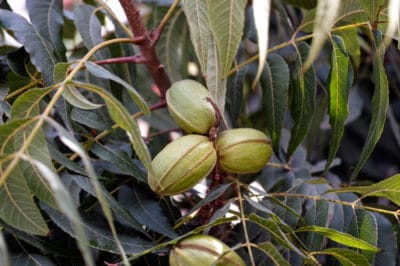Where Hickory Trees Grow
Of the world’s 19 hickory species, 13 are North American natives – 12 from the United States and one from eastern Mexico. The remaining five species grow in China, India and Vietnam.
Hickories for Home Landscapes
Five native U.S. hickories pair sweet nuts with mature sizes suitable for large home landscapes. They regularly exceed 80 feet tall, with canopies at least half as wide as their heights. They also send down deep taproots, so consider them permanent landscape additions.
- Shagbark hickory (Carya ovata) grows in USDA zones 4 through 8, where it thrives in fertile, moist well draining soil and partial to full sun. Its shaggy bark provides year-round ornamental interest.
- Shellbark hickory (Carya laciniosa) grows in USDA zones 5 through 8. It handles occasional flooding but grows best in fertile, moist well draining soil. Give it full sun to partial shade. It also boasts highly ornamental bark.
- Mockernut hickory (Carya tomentosa) also grows in full sun to partial shade. It’s suitable for USDA zones 4 through 9. It tolerates dry sites but does best in fertile, moist well draining soil.
- Sand hickory (Carya pallida) grows in USDA zones 6b through 9a. It likes moderately moist to moderately dry sandy or loam soil and full to partial sun.
- Red hickory (Carya ovalis) prefers a wind-sheltered site with deep, moist loamy soil and full sun. It grows in USDA zones 5 through 9.
Expert gardener’s tips: The pecan hickory (Carya illinoinensis) has the tastiest nuts of all. But at up to 130 feet tall, it’s best left to commercial growers and urban landscapes.
Know Before You Plant
Other than pecans, hickories are notoriously slow growers. Expect to wait 25 years to harvest nuts; many trees take at least 40 to produce their first crop.
Hickories and Wildlife
Hickory nuts trail only acorns as wildlife’s most important food source — and unlike oaks, the trees produce a yearly crop. Their flowers attract spectacular moths, including Lunas, Imperials and Banded Sphinxes. Endangered Indiana bats roost under their peeling bark, along with countless bird-attracting insects. If you’re looking for a tree to anchor a wildlife garden, look no further than a hickory.
